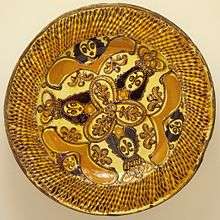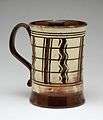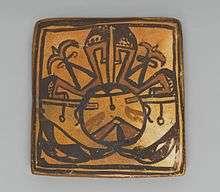Slipware

Slipware is pottery identified by its primary decorating process where slip is placed onto the leather-hard clay body surface before firing by dipping, painting or splashing. Slip is an aqueous suspension of a clay body, which is a mixture of clays and other minerals such as quartz, feldspar and mica. The slip placed onto a wet or leather-hard clay body surface by a variety of techniques including dipping, painting, piping or splashing.[1]
Principal techniques include slip-painting, where the slip is treated like paint and used to create a design with brushes or other implements, and slip-trailing (or barbotine decoration), where the slip, usually rather thick, is dripped, piped or trailed onto the body, typically from some device like the piping bag used to decorate cakes.[2]
Often only pottery where the slip creates patterns or images will be described as slipware, as opposed to the many types where a plain slip is applied to the whole body, for example most fine wares in Ancient Roman pottery, such as African red slip ware (note: "slip ware" not "slipware"). Decorative slips may be a different colour than the underlying clay body or offer other decorative qualities. Selectively applying layers of colored slips can create the effect of a painted ceramic, such as in the black-figure or red-figure pottery styles of Ancient Greek pottery. Slip decoration is an ancient technique in Chinese pottery also, used to cover whole vessels over 4,000 years ago.[3]
Techniques
A coating of white or coloured slip (sometimes called by the French term engobe in American English) can be applied to the whole body of the article, or just one part, such as outside or inside of a cup or jug, to improve its appearance, to give a smoother surface to a rough body, mask an inferior colour or for decorative effect. Slip can also be applied by painting techniques, in isolation or in several layers and colours. Sgraffito (or "sgraffiato") involves scratching through a layer of coloured slip to reveal a different colour or the base body underneath. Several layers of slip and/or sgraffito can be done while the pot is still in an unfired state. One colour of slip can be fired, before a second is applied, and prior to the scratching or incising decoration. This is particularly useful if the base body is not of the desired colour or texture.[4]
Chinese pottery also used techniques where patterns, images or calligraphy were created as part-dried slip was cut away to reveal a lower layer of slip or the main clay body in a contrasting colour. The latter of these is called the "cut-glaze" technique.[5]
Slipware may be carved or burnished to change the surface appearance of the ware. Specialized slip recipes may be applied to biscuit ware and then refired.
History
Many prehistoric and historic cultures used slip as the primary decorating material on their ware, especially in early periods. These include most prehistoric cultures of the Middle East and much later Islamic pottery, cultures in many areas of Africa, most pottery-making cultures in the Americas, early Japanese (and later Onta ware) and much Korean pottery. Much Mycenean ware, Ancient Greek pottery and Ancient Roman pottery used slip, as did pre-industrialized potters in many areas of Europe, including Great Britain, most notably Thomas Toft in the Staffordshire Potteries.[6]
Later potters mostly combined or replaced the use of slip with ceramic glazes and pigments offerig a tougher finish and a wider range of colours. But a variety of slipware techniques were revived by various studio pottery movements from the 19th century on. In England Bernard Leach and in America Mary Louise McLaughlin were among the leaders of these revivals.[7]
Gallery
- Simple slip-trailing in thick blobs, Roman Egypt, 0-200 AD
- Bowl with strutting bird, Sultanabad ware, Iran, Ilkhanid period, first half of 14th century, earthenware with gray englobe and underglaze painting in blue, black, white slip
- Korean punch'ong ware pear-shaped wine bottle, Choson dynasty, second half of 15th century, stoneware with glaze and white slip decoration
 English Slipware mug, ca. 1740
English Slipware mug, ca. 1740 Ashiwi slip-painted jar, She-we-na Zuni Pueblo, 1700-1750
Ashiwi slip-painted jar, She-we-na Zuni Pueblo, 1700-1750- Sugar bowl with combed, slip-marbled decoration, China, c. 1795, porcelain
 Tile, Hopi Pueblo, late 19th-early 20th century
Tile, Hopi Pueblo, late 19th-early 20th century- Modern slip-trailed bowl by Takeshi Yasuda
See also
- Culture of Korea
- History of pottery in Palestine
- Native American pottery
- Pottery of Ancient Greece
- Harvest jug
Notes
References
- Eden, Victoria and Michael. (1999) Slipware, Contemporary Approaches. A & C Black, University of Pennsylvania Press, G & B Arts International. ISBN 90-5703-212-0
- Hamer, Frank and Janet. (1991) The Potter's Dictionary of Materials and Techniques. A & C Black, 3rd ed. ISBN 0-8122-3112-0.
- Osborne, Harold (ed), The Oxford Companion to the Decorative Arts, 1975, OUP, ISBN 0198661134
- Vainker, S.J., Chinese Pottery and Porcelain, 1991, British Museum Press, 9780714114705
- Wondrausch, Mary. (2001) [1986] Mary Wondrausch on Slipware. A&C Black, 2nd ed. ISBN 0-7136-2813-8
External links
![]() Media related to Slipware at Wikimedia Commons
Media related to Slipware at Wikimedia Commons